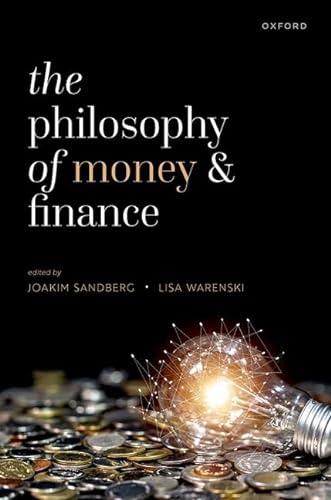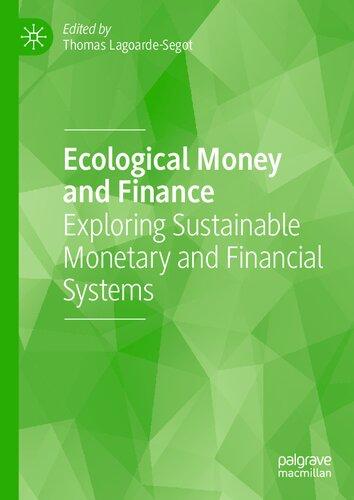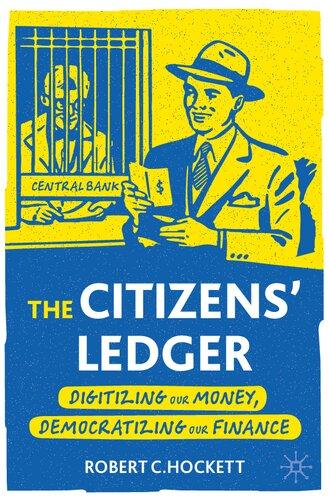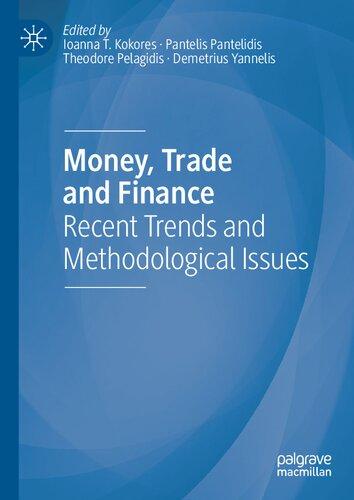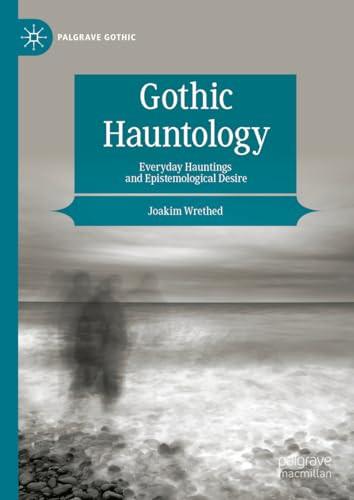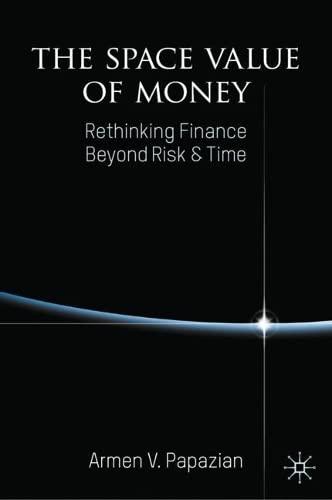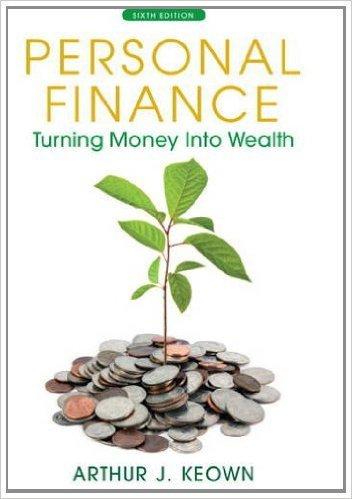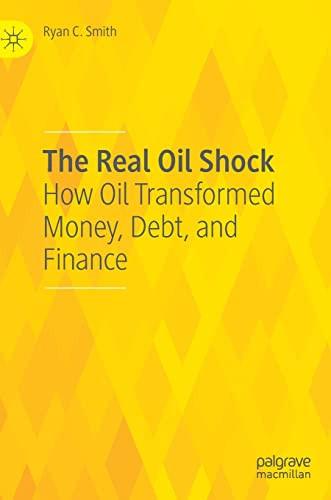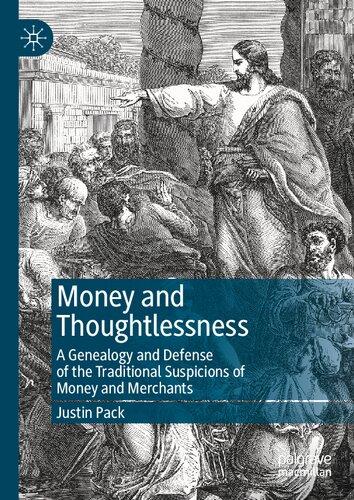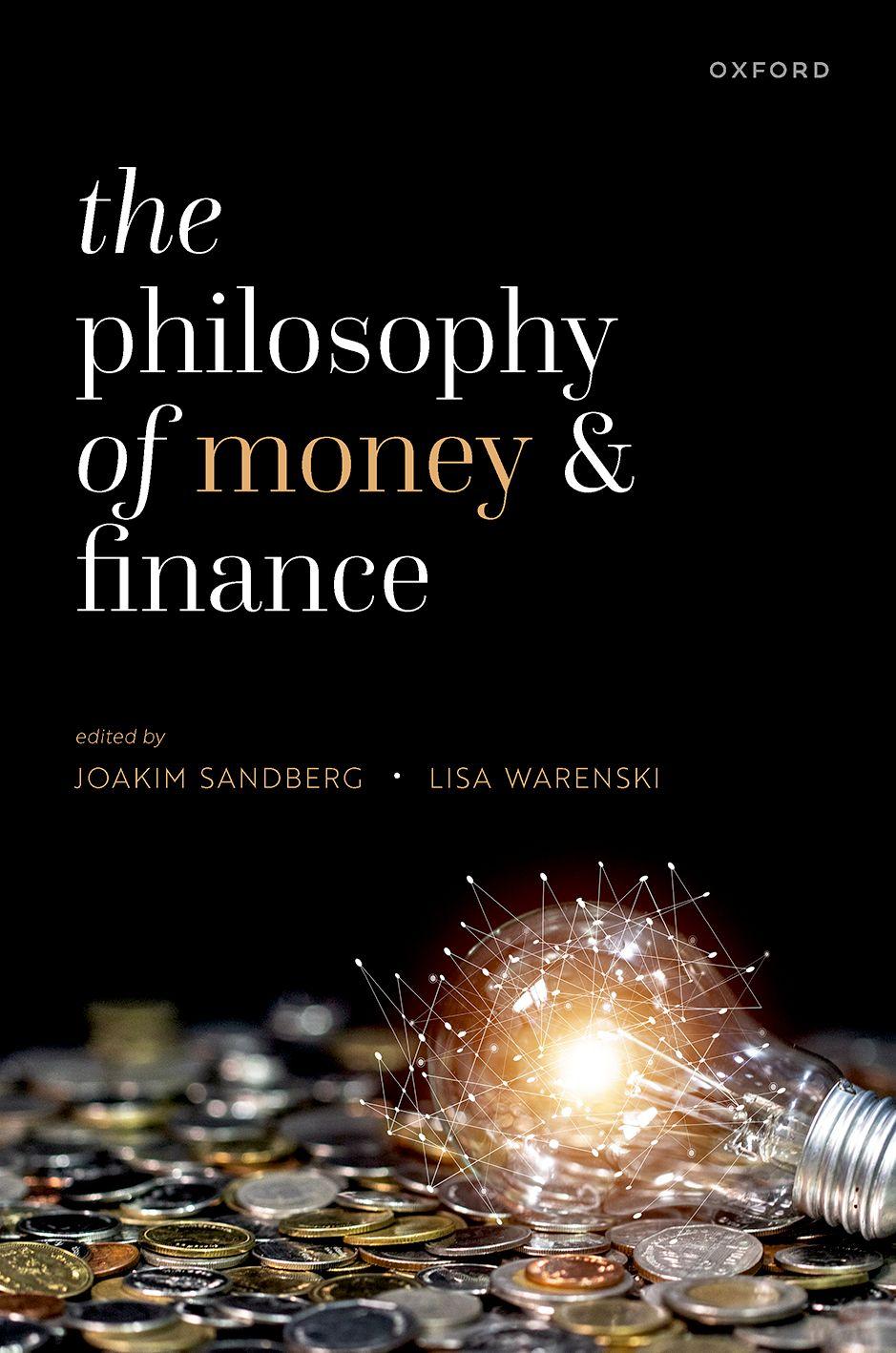The Philosophy of Money and Finance 1st Edition Joakim Sandberg Visit to download the full and correct content document: https://ebookmass.com/product/the-philosophy-of-money-and-finance-1st-edition-joak im-sandberg/
More products digital (pdf, epub, mobi) instant download maybe you interests ...
Ecological Money and Finance Thomas Lagoarde-Segot
https://ebookmass.com/product/ecological-money-and-financethomas-lagoarde-segot/
The Citizens' Ledger: Digitizing Our Money, Democratizing Our Finance 1st Edition Robert C. Hockett
https://ebookmass.com/product/the-citizens-ledger-digitizing-ourmoney-democratizing-our-finance-1st-edition-robert-c-hockett/
Money, Trade and Finance: Recent Trends and Methodological Issues Kokores
https://ebookmass.com/product/money-trade-and-finance-recenttrends-and-methodological-issues-kokores/
Gothic Hauntology: Everyday Hauntings and Epistemological Desire 1st Edition Joakim Wrethed
https://ebookmass.com/product/gothic-hauntology-everydayhauntings-and-epistemological-desire-1st-edition-joakim-wrethed/
The Space Value of Money: Rethinking Finance Beyond Risk & Time
Armen V. Papazian
https://ebookmass.com/product/the-space-value-of-moneyrethinking-finance-beyond-risk-time-armen-v-papazian/
eTextbook 978-0132719162 Personal Finance: Turning Money into Wealth (6th Edition) (The Prentice Hall Series in Finance)
https://ebookmass.com/product/etextbook-978-0132719162-personalfinance-turning-money-into-wealth-6th-edition-the-prentice-hallseries-in-finance/
The Real Oil Shock: How Oil Transformed Money, Debt, and Finance Ryan C. Smith
https://ebookmass.com/product/the-real-oil-shock-how-oiltransformed-money-debt-and-finance-ryan-c-smith/
The 30-Day Money Cleanse: Take Control of Your Finances, Manage Your Spending, and De-Stress Your Money for Good (Personal Finance and Budgeting SelfHelp Book) Feinstein Gerstley
https://ebookmass.com/product/the-30-day-money-cleanse-takecontrol-of-your-finances-manage-your-spending-and-de-stress-yourmoney-for-good-personal-finance-and-budgeting-self-help-bookfeinstein-gerstley/
Money and Thoughtlessness. A Genealogy and Defense of the Traditional Suspicions of Money and Merchants Justin Pack
https://ebookmass.com/product/money-and-thoughtlessness-agenealogy-and-defense-of-the-traditional-suspicions-of-money-andmerchants-justin-pack/
ThePhilosophyof MoneyandFinance Editedby JOAKIMSANDBERG and LISAWARENSKI
GreatClarendonStreet,Oxford,OX26DP, UnitedKingdom
OxfordUniversityPressisadepartmentoftheUniversityofOxford. ItfurtherstheUniversity’sobjectiveofexcellenceinresearch,scholarship, andeducationbypublishingworldwide.Oxfordisaregisteredtrademarkof OxfordUniversityPressintheUKandincertainothercountries
©OxfordUniversityPress2024
ExceptChapter1©JoakimSandbergandLisaWarenski
Themoralrightsoftheauthorshavebeenasserted
Allrightsreserved.Nopartofthispublicationmaybereproduced,storedin aretrievalsystem,ortransmitted,inanyformorbyanymeans,withoutthe priorpermissioninwritingofOxfordUniversityPress,orasexpresslypermitted bylaw,bylicenceorundertermsagreedwiththeappropriatereprographics rightsorganization.Enquiriesconcerningreproductionoutsidethescopeofthe aboveshouldbesenttotheRightsDepartment,OxfordUniversityPress,atthe addressabove
Youmustnotcirculatethisworkinanyotherform andyoumustimposethissameconditiononanyacquirer
PublishedintheUnitedStatesofAmericabyOxfordUniversityPress 198MadisonAvenue,NewYork,NY10016,UnitedStatesofAmerica
BritishLibraryCataloguinginPublicationData Dataavailable
LibraryofCongressControlNumber:2023942266
ISBN978–0–19–289880–7
DOI:10.1093/oso/9780192898807.001.0001
Printedandboundby
CPIGroup(UK)Ltd,Croydon,CR04YY
LinkstothirdpartywebsitesareprovidedbyOxfordingoodfaithand forinformationonly.Oxforddisclaimsanyresponsibilityforthematerials containedinanythirdpartywebsitereferencedinthiswork.
ListofContributors vii Introduction1
JoakimSandbergandLisaWarenski
I.METAPHYSICS 1.TheSocialOntologyofMoney15 FrankHindriks
2.Cryptocurrency:CommodityorCredit?32 AsyaPassinsky
3.HowManyPeopleDoesItTaketoMakeaDollar?54 DavidG.Dick
4.TruthinFinancialAccounting70 ChristopherJ.Cowton
II.EPISTEMOLOGY 5.AreFinancialMarketsEpistemicallyEfficient?91 LisaHerzog
6.FinancialEconomics:WhatKindofScienceIsIt?111 ConradHeilmann,MartaSzymanowska,andMelissa Vergara-Fernández
7.JPMorganChase’ s “LondonWhale” TradingLosses:ATaleof HumanFallibility129 LisaWarenski
8.ClimateChangeandReflexiveLaw:TheEUSustainable FinanceActionPlan148 BoudewijndeBruin
III.ETHICS 9.IsthePursuitofMoneyIncompatiblewithMorality?Some HistoricalandPhilosophicalReflections171 AdrianWalsh
10.VirtueTheoryandtheEthicsofFinance191
KatePadgettWalshandNolanPithan
11.OntheWrongfulnessofBankContributionstoFinancialCrises207
RichardEndörfer
12.MoneyintheSocialContract226
AaronJames
IV.POLITICALPHILOSOPHY
13.CreditandDistributiveJustice247
MarcoMeyer
14.FreedomandFinancialMarketReform264
JoshuaPreiss
15.GreenCentralBanking283
PeterDietsch,ClémentFontan,JérémieDion,and FrançoisClaveau
16.BitcoinsLeftandRight:ANormativeAssessmentofaDigital Currency303
JoakimSandbergandLarsLindblom
ListofContributors BoudewijndeBruin isProfessorofFinancialEthicsatUniversityofGroningen,the Netherlands,andVisitingProfessorintheFinancialEthicsResearchGroupatUniversity ofGothenburg,Sweden.Heistheauthorof EthicsandtheGlobalFinancialCrisis:Why IncompetenceIsWorsethanGreed (CambridgeUniversityPress,2015)and TheBusinessof Liberty:FreedomandInformationinEthics,Politics,andLaw (OxfordUniversityPress, 2022).
FrançoisClaveau isAssociateProfessorofAppliedEpistemologyatUniversityof Sherbrooke,Canada.Heisaphilosopherofthesocialscienceswithamultidisciplinary background(philosophy,politicalscience,economics,scienceandtechnologystudies).He currentlyholdstheCanadaResearchChairinPracticalEpistemology.
ChristopherJ.Cowton isEmeritusProfessoratHuddersfieldBusinessSchool,University ofHuddersfield,UK,wherehewaspreviouslyProfessorofAccounting(1996–2016)and ProfessorofFinancialEthics(2016–2019).Healsohasapart-timeroleasAssociate DirectorattheInstituteofBusinessEthics,aregisteredcharitythatpromoteshigh standardsofethicalbusinessbehaviour.Foroveradecade,hewaseditorofthejournal BusinessEthics:AEuropeanReview
DavidG.Dick wasAssociateProfessorofPhilosophyandFellowintheCanadianCentre forAdvancedLeadershipinBusiness,HaskayneSchoolofBusiness,atUniversityof Calgary,Canada.Hisresearchinterestswerethephilosophyofmoney,businessethics, andmetaethics.
PeterDietsch isProfessorintheDepartmentofPhilosophyatUniversityofVictoria, Canada.Heistheauthorof CatchingCapital:TheEthicsofTaxCompetition (Oxford UniversityPress,2015)andco-authorof DoCentralBanksServethePeople? (PolityPress, 2018).
JérémieDion isaPhDcandidateinScienceandTechnologyStudiesatUniversityof QuebecatMontreal,Canada.Hisresearchinterestsaresocialepistemology,philosophy ofscience,politicalphilosophy,andcomputationalhumanities.
RichardEndörfer isAssociateResearcherinPracticalPhilosophyandmemberofthe FinancialEthicsResearchGroupatUniversityofGothenburg,Sweden.Herecently finished hisPhDthesisentitled “WeaponsofMassDestruction:FinancialCrisesfroma PhilosophicalPerspective” (2022).
ClémentFontan isProfessorofEuropeanEconomicPoliciesatCatholicUniversityof Louvain,Belgium.Hehaspublishedwidelyinphilosophy,politics,andeconomics.His fieldsofspecializationarepoliticaleconomy,Europeanstudies,centralbanks,and financial ethics.
ConradHeilmann isAssociateProfessorofPhilosophyandCo-DirectoroftheErasmus InstituteforPhilosophyandEconomicsattheErasmusSchoolofPhilosophy,Erasmus UniversityRotterdam,theNetherlands.Herecentlyco-editedthe RoutledgeHandbookof thePhilosophyofEconomics (Routledge,2021).
LisaHerzog isProfessorofPoliticalPhilosophyandDirectoroftheCenterforPhilosophy, PoliticsandEconomicsatUniversityofGroningen,theNetherlands.ShewasaRhodes ScholaratUniversityofOxford(2007–2010).Shehaswonseveralawardsforherresearch, includingtheSirErnestBarkerPrizeinpoliticaltheory(2011),theDeutscherPreisfür PhilosophieundSozialethik(2019),andtheAmmodoScienceAwardforfundamental research(2021).
FrankHindriks isProfessorofEthics,SocialandPoliticalPhilosophyatUniversityof Groningen,theNetherlands.Hisresearchconcernssocialontologyandcollectiveethics.He isamemberoftheRoyalHollandSocietyofSciencesandHumanitiesandafounding memberoftheInternationalSocialOntologySociety.
AaronJames isProfessorofPhilosophyatUniversityofCalifornia,Irvine,USA.Heisthe authorof FairnessinPractice:ASocialContractforaGlobalEconomy (OxfordUniversity Press,2012)andco-authorof MoneyfromNothing:WhyWeShouldLearntoStop WorryingaboutDebtandLovetheFederalReserve (MelvilleHousePress,2020).
LarsLindblom isSeniorAssociateProfessorinAppliedEthicsatLinköpingUniversity, Sweden.Heworkswithissuesintheintersectionsbetweentheoriesofjustice,publicpolicy, andscience.Heisexecutiveeditorofthejournal DeEthica AJournalofPhilosophical, Theological,andAppliedEthics.
MarcoMeyer isResearchGroupLeadinPhilosophyatUniversityofHamburg,Germany. HeholdsaPhDinPhilosophyfromtheUniversityofCambridgeandaPhDinEconomics fromtheUniversityofGroningen.Hisresearchgroupinvestigateswhatorganizationshave adutytoknowandwhatqualitieshelpthemtofulfillthoseduties.
KatePadgettWalsh isAssociateProfessorofPhilosophyatIowaStateUniversity, USA.SheisinterestedinpointsofintersectionbetweenHegel’sthoughtandcontemporary ethicalissues.Herrecentworkhasexaminedtheethicaldimensionsofdebtinlightof recentsocialandpoliticaldevelopments.
AsyaPassinsky isAssistantProfessorofPhilosophyatCentralEuropeanUniversityin Vienna,Austria.ShewasaRhodesScholaratUniversityofOxford,whereshecompleted herBPhilinphilosophy.Sheiscurrentlywritingabookonthemetaphysicsofsocial objects.
NolanPithan recentlygraduatedwithaBAinPhilosophyfromIowaStateUniversity, USA.
JoshuaPreiss isProfessorofPhilosophyandDirectorofthePrograminPhilosophy, Politics,andEconomicsatMinnesotaStateUniversity,Mankato,USA.Heistheauthor of JustWorkforAll:TheAmericanDreaminthe21stCentury (Routledge,2021)aswellas creatorandhostofthepodcastseries PandemicEthics
JoakimSandberg isProfessorofPracticalPhilosophyandDirectoroftheFinancialEthics ResearchGroupatUniversityofGothenburg,Sweden.HeisalsoProfessorofEconomics andFinancefromaHumanistPerspectiveatUniversityofGroningen,theNetherlands,and ViceDirectoroftheSustainableFinanceLab,acollaborationbetweenseveralSwedish universitiesandcompanies.
MartaSzymanowska isAssociateProfessorofFinanceintheDepartmentofFinanceat RotterdamSchoolofManagement,ErasmusUniversityRotterdam,theNetherlands.She haspublishedinleadingacademicjournalssuchas JournalofFinance and Journalof FinancialEconomics.
MelissaVergara-Fernández isPostdoctoralResearcherinPhilosophyattheErasmus InstituteforPhilosophyandEconomics,ErasmusSchoolofPhilosophy,Erasmus UniversityRotterdam,theNetherlands.Sheworksonthephilosophyofscienceof financial economics,withacurrentfocusoneconomicmodelingandmodelfailure.
AdrianWalsh isProfessorofPhilosophyandPoliticalTheoryatUniversityofNew England,Australia,andVisitingProfessorintheFinancialEthicsResearchGroupat UniversityofGothenburg,Sweden.Heistheco-authorof TheMoralityofMoney:An ExplorationinAnalyticPhilosophy (PalgraveMacmillan,2008)andco-editorof TheEthical UnderpinningsofClimateEconomics (Routledge,2016).
LisaWarenski isAffiliatedAssociateProfessorofPhilosophyattheCityUniversityof NewYorkGraduateCenter,USA,andResearchAssociateatUniversityofConnecticut, USA.Sheisaformercorporatecreditanalystandloanofficerwithovereightyears’ experienceworkinginmajormoneycenterbanksinNewYorkCity.
Introduction JoakimSandbergandLisaWarenski
Wouldn’titbestrangeifthereweresomethingthatweusedalmosteverydayand whichwassoimportanttousthatitdeterminedourfatebothasindividualsandas societies,yetweseldomstoppedtothinkaboutwhatitis,howitworks,andhowit oughttowork?Webelievethatthereissuchathing:money.Mostpeoplein contemporarysocietyusemoneynearlyeveryday,intheformofeithercashor electronictransactions.Ourfateasindividualsisoftenconnectedtohowmuch moneywemake,andwhetherwemanagetosavesomeofitinthebankorinvestit in financialassets.Anditisultimatelythe flowofmoneyinsocietythatdeterminesourcommonfuture.Yet,werarelystoptoconsiderthecuriousnatureof thisthingcalledmoney ifitisevena “thing” atall.Howcanthosesmallpiecesof paperinyourwalletbesuchabigdeal?Howcansomethingsoabstracthavesuch tangibleconsequencesinsociety?Andwhatisaplausibleethicalstancetohave towardmoney?
Ifmoneyisstrange,thenthebroaderworldof financeisevenstranger. “Finance ” isanumbrellatermthatencompassesvariousaspectsofthemanagementofmoneyandthebuyingandsellingofmoney-likeassets.Typicalsuch assetsincludestocks,bonds,creditcontracts,insurancecontracts,andderivatives (futures,options,swaps,etc.). “Finance” canalsorefertotheinstitutionalinfrastructurethatweusetomanagetheseassets,whichincludesorganizationssuchas banks,investmentfunds,andcentralbanks.Howcantheseveryabstract “assets” havesuchimportance?Howcansomuchpoweroverourdestinybevestedinthe numbersthatrollacrossbankers’ computerscreens?Andwhatroleshouldwegive to financialassetsand financialinstitutionsinoursociety?
Thephilosophyofmoneyand financeseekstoanswerthesetypesofquestions, andtakesalook “underthehood” ofmoneyand finance.Utilizingthetoolsof analyticphilosophy,itseekstoelucidateandcriticallyassessthenatureofthe financialrealmandthenormsthatguideit.Wemightsaythatoneofthegoals ofthedisciplineistomaketheinvisible,unapparent,orsimplyunnoticed structuresofmoneyand financemorevisibletous.Thisisimportantsothatwe canbetterunderstand,interpret,andevaluatethem.Anothergoalmaybeto proposeimportantchangestothosestructuresinthelightofcentralethicalor politicalaims.
JoakimSandbergandLisaWarenski, Introduction In: ThePhilosophyofMoneyandFinance. Editedby:JoakimSandberg andLisaWarenski,OxfordUniversityPress.©OxfordUniversityPress2024. DOI:10.1093/oso/9780192898807.003.0001
Philosophizingaboutmoneyand financeisnotentirelynew,ofcourse.Already inantiquity,PlatoandAristotletheorizedaboutthetruenatureandpurposeof money.IntheMiddleAges,AugustineandThomasAquinascontinuedthis traditionand,amongotherthings,soughttoreconcilethenormsofthemarket withthedemandsofvirtue.IntheEarlyModernperiod,philosopherssuchas AdamSmithandJohnStuartMilldevelopedamoreindividualisticandutilitarian perspectiveonmoneyandmarkets,whichultimatelygaverisetotheseparate disciplineofeconomics.Economicshasevolvedintoamoreempiricallyoriented studyofproductiveactivitiesand financial flowsthatiscoupledwithamore mathematicalstyleoftheorizingandmakingpredictions.Whileeconomics,of course,hasalottoteachusaboutthepracticalsideofmoneyand finance,we wouldarguethatitcannotanswersomeofthemorefundamentalandnormative questionsaboutthem.
Fortunately,overthelasthalfcenturyorso,therehasbeenarenewedand growinginterestinphilosophicaltreatmentsofmoneyand finance.Wesuggest thatthereareseveralpossibleexplanationsforthis.Oneisthetransformationof Westernsocietyintowhatissometimescalled financialcapitalism thatis,aform ofmarketeconomyinwhich financeandinvestmentplaysanever-increasingrole. Anotherexplanationisthegrowingawarenessinsocietyofthemanysubstantial challengesthatoureconomicsystemnowfaces including financial,public health,andsocialcrises,aswellastheglobalclimatecrisis.Relatedly,therehas perhapsbeenagrowingawarenessinacademiaoftheimportantlimitationsof economicswhenitcomestoaddressingsomeofourmorefoundationaland normativequestionsabout financialassetsandtheirdistribution.Thesechallenges seemtocallforscholarshipthatgoesbeyondthereadilyobservableandquantifiable. Itseemsfairtosaythatacademicwritingonthephilosophyofmoney and financereallyhastakenoffduringthelasttwodecades.Asignificantevent duringthistimewastheGlobalFinancialCrisisof2008.Accordingtomany,the crisisexposedsignificantdefectsintheglobal financialsystemthatneedtobe addressedinvariousways.Italsodemonstratedhowall-importantthatsystemhas becometothebroadereconomyandsociety.Asisoftenthecase,timesof crisisspurrednewideasandanincreasedinterestinalternativethinkingabout animportantsubject.
AboutThisVolume Thepurposeofthiseditedvolumeistoprovideacomprehensiveintroductionto theemerging fieldofthephilosophyofmoneyand finance.Wehavegathered togethersomeoftheleadingscholarsinthe field,aswellassomeemerging scholars,tocontributetheirthoughtsonwhatweperceivetobesomeofthe mostsignificanttopics.Eachofthechaptersisanewtext,writtenexclusivelyfor
thisvolume.Wehavemadeaspecialefforttodemonstratethefullbreadthofthe field fromveryfoundationalquestionstomoreappliedones,andfromvery theoreticalquestionstomorenormativeones.
Thevolumeisdividedintofourmainparts,correspondingtofourmajor subdisciplinesinanalyticphilosophy:Metaphysics,Epistemology(including PhilosophyofScience),Ethics,andPoliticalPhilosophy.Eachpartcontainsfour chaptersondifferentbutinterrelatedtopics.Theparticulartopicsinthechapters reflecttheinterestsoftheirauthors,andtherearenodoubtadditionaltopicsthat couldbeunderstoodtobecentralandcouldhavebeenincluded.Butonehasto startsomewhere,andwehopethatsomeoftheseothertopicscanbetakenupin futurework.
Wehopethatthereaderwill findthisvolumeusefulinseveralways.First,we haveaimedtokeepthetextsasaccessibleandnon-technicalaspossiblesothat theycanbereadbyabroadrangeofpeople,includingscholarsfromadjacent disciplines,students,andtheintellectuallycuriouspublic.Wetherebyhopethatit canserveasanintroductiontothisfascinating fieldofinquiry.Second,wehave aimedtogiveacomprehensiveoverviewofthetypesofquestionsandperspectives thatarecommonintheburgeoningliteratureinthe field.Wetherebyhopethat thevolumecanbeusedasaroadmapthatpointsthereaderfurthertowardmore specifictopicsordiscussionsthatareofparticularinterest.Finally,thechapters arenotmerelydescriptivebutcontainoriginalandsometimescontroversial contributionstoongoingacademicdebates.Wetherebyinvitethereaderto engageinphilosophicalreflectionandtojoinusinthecontinuedphilosophical discussionanddebateaboutmoneyand finance.
PartI:Metaphysics Metaphysicsisthephilosophicalstudyofthenatureofreality,boththenatural realitythatweliveinandthesocialrealitythatwehelptocreate.Asnoted,money and financearestrange “things” indeedinthesensethattheremustbemoreto themthanjustthepiecesofpaperinourwalletsandthenumbersoncertain computerscreens.Theyareinsomesenseabstractentitiesthatexistonthebasis ofsocialconventionsorpractices.Butexactlyhowdoesthatwork?Whatisitthat makesthosepiecesofpaperintomoney,andwhatmakesthenumbersonthe bankers’ computerscreenshave financialvalue?
Ifthenatureofmoneyand financewasalreadystrangeinancienttimes,ithas becomeallthemoresooverroughlythelasthalfcenturywiththeadventof electronicbankaccounts,creditcards,andBitcoin.Thesetechnologicalinventions havecreatedasituationinwhichour financescanfeelevenmoreabstractandout ofreach.Happily,however,itseemsthatthesedevelopmentshaverejuvenatedthe philosophicaldiscussionaboutthenatureofmoneyand finance.Somearguethat
weneednewtheoriestoaccountforthesenewformsofmoney,whileothersargue thatthedevelopmentshelpustoseethetruenatureofmoneythathasbeenthe sameallalong.
PartIofthisvolumecontainsfourchapters:threethatconcernthenatureof moneyandonethatconcernstruthin financialaccounting,adomainthatis centralto finance.InChapter1,FrankHindriksanalyzesthenatureofmoneyon thebasisofcontemporarydebatesinthe fieldofsocialontology.Morespecifically, heinvestigateswhetheronecangiveaunifiedmetaphysicalaccountofboth traditionalmoney,forexamplepapernotes,andmodernmoney(electronic bankaccounts).Whereaspapermoneyisnaturallyregardedasamaterialor concreteobject,thesamedoesnotseemtoholdforelectronicmoney.Evenif weweretodestroythecomputersthatstoretheelectronicinformationaboutour money,wewouldnotsaythatitislost.Shouldwethereforesaythatmoneyis alwaysanabstractobject(e.g.acreditrelation),orisitperhapsbetterconceivedof asapropertyofanagent(e.g.thepropertyofhavingpurchasingpower)?Hindriks ultimatelyarguesthatnounifiedaccountcanbegiven,andthereforeweshould saythatmoneyissometimesamaterialobjectandsometimesthepropertyof anagent.
InChapter2,AsyaPassinskyanalyzesthenatureofcryptocurrencieslike Bitcoin.Drawingonclassicalphilosophicaltreatmentsofthenatureofmoney, themainalternativesagainseemtoviewitaseithersomethingconcrete,a commodity,orsomethingabstract,acreditrelation.Lookingcloseratthosetwo strandsoftheliterature,theyseemtopresentratherdifferentstoriesaboutnot onlymoney’snaturebutalsoitsoriginandfunction.Passinskyproceedstodiscuss thenature,origin,andfunctionofcryptocurrenciesinordertocomparethem withthetheoreticalalternatives.Shearguesthatbothoftheclassicalaccountscan capturesomeofthestoryofcryptocurrencies,butthatneitherofthemseems perfectforthejob;wethereforeneedtoexploreahybridaccount.Inspiredby Aristotle,Passinskycallsherownaccounta “hylomorphic” onethatseescryptocurrenciesasbothconcreteandabstractatthesametime.
InChapter3,DavidG.Dickgivesanewtwisttothediscussionbyaskinghow manypeopleitwouldtaketocreateanewcurrency.Wetypicallytakethe longevityandwidespreaduseofthedollarasasignthatitismore “realmoney” than,forexample,Bitcoinandothercryptocurrencies.However,Dickarguesthat wemustbecarefultoseparatethemetaphysicalquestion,aboutwhat is money, fromthenormativequestion,aboutwhatis better money.Uponreviewofthe metaphysicaltheories,itseemsthatwhatmakessomethingintomoneyiseitherits functionalityoritssocialacceptance.Dickthengoesontoarguethatirrespective ofwhatmetaphysicalpositiononeadopts,itwouldtakenomorethantwopeople tocreateanewcurrencybecausehavingtwopeopleissuf ficientforsomethingto beabletofunctionasamediumofexchange,aunitofaccount,andastore ofvalue.
InChapter4,ChristopherJ.Cowtontakesupthemetaphysicalquestionofthe natureoftruthinthedomainof financialaccounting.Financialaccountingis centraltobusinessand financeinthatitisthesystembywhichtransactionsare recorded,summarized,andpresented.Cowtondemonstratesseveraldifficult decisionsthataccountantsfacewhenitcomestodelineating,timing,andvaluing various financialtransactions.Thequestionisthenwhetheroneoftheseoptions willgivethe true accountofthetransactions,andinwhatsenseof “true.” He considersthreeprominentphilosophicalaccountsoftruth:correspondence(with someexternalreality),coherence(withestablishedpropositions),andusefulness (forsomebroaderhumanpurposes).Cowtonultimatelyarguesthatallthreeof thesenotionsoftruthhavesomeresonancewithwhataccountantsaretryingto do,evenifitseemsdifficulttogiveanexacttheoryoftruthfor financialaccounts. Thus,itisnotthecasethat “anythinggoes” inthisrealm.
PartII:Epistemology Epistemologyisthephilosophicalstudyofcognitivesuccesses,suchasknowledge, understanding,andjustifiedbelief,andtheprocessesandmethodsthatrealize them.Correlatively,epistemologystudiescognitivefailures.Giventheelusiveand partiallyabstractnatureofmoneyand finance,itisnotdifficulttoseehowthere aremanyquestionsabouthowwecanandshouldgoaboutformingjudgments withinandaboutthe financialrealm.Financialagents,bothindividuallyand collectively,engageinjudgmentsaboutvarious financialassetsandhowto managethem.Insodoing,theymust,amongotherthings,makejudgments about financialrisk.TheGlobalFinancialCrisisdemonstratedwithexcruciating claritywhatcanhappenwhenbankersfailtounderstandwhatriskstheyare takingand,consequently,whatriskstheyareimposingonsociety.
Connectedtoepistemologyisthedisciplineofphilosophyofscience,which encompassesthephilosophicalstudyofscientificmethodsofunderstanding includingtheirfoundations,reliability,andimplications.Economics,includingits subdiscipline financialeconomics,isthesciencethatstudiesthe financialrealm. Financialeconomicsisafairlyyoungscience,butithasquicklybecomewell respected(asdemonstrated,e.g.,byseveralNobelMemorialPrizes),anditisheld inhighregardbythe financialindustry.Truthbetold,however,evenmost financialeconomistscameratherunpreparedfortheGlobalFinancialCrisisand theseveredefectsthatitexposedintheglobal financialsystem.Thereistherefore anincreasingandimportantdebateamongbothphilosophersandeconomists aboutthereliabilityofsomeofthecentralmethodsandassumptionsof financial economics.
PartIIcontainsfourchapters:twoaddressepistemicissuespertainingto financialeconomics,andtwoconsiderapplicationsofepistemologyin financial
practice.InChapter5,LisaHerzogconsiderstheconditionsunderwhich financial marketscanbeexpectedtogiveusundistortedandusefulinformationabout therealeconomy.Accordingtomainstream financialeconomics,assetprice developmentstellussomethingabouteconomicfundamentalsbecausethey containinformationaboutcurrentandfutureprofits,wheretheseprofits areadjustedbyestimationsaboutrisk.Butcanwereallytrustthe financial marketstoaccuratelyrepresenteconomicfundamentals?Herzogarguesthat whatwewanthereis “epistemicefficiency,” whichistosaythatwewantthe marketstorepresentinformationthatisrelevanttoourcentralneedswithout systematicdistortions.However, financialmarketscannotbeassumedtobe epistemicallyefficientsincetheyarerifewithdistortions.Shearguesthat epistemicefficiencyshouldthereforebeunderstoodasaguidingprinciplefor futureregulationof financialmarketsasopposedtoanautomaticfeatureof them.Furthermore,inorderfortheinformationthatthesemarketsrepresentto besociallyworthwhile,reformsinotherpartsoftheeconomicsystemwould beneeded.
Chapter6,authoredbyConradHeilmann,MartaSzymanowska,andMelissa Vergara-Fernández,providesaroadmapforhowphilosophersofsciencecould engagemorewiththescienceof financialeconomics.Thechapterbeginsby givinganabridgedaccountoftheemergenceof financialeconomics,identifying itshistoricaloriginsandtracingitsevolutionintoadistinctbranchofeconomics. Theauthorsthengoontoarguethat financialeconomicsisbestcharacterizedby its useofmodels andits performative nature.Thisargumentismadethrough considerationoftheCapitalAssetPricingModel(CAPM),amodelthatplayed andcontinuestoplayacentralroleinanalyzingassetprices.Thecentralityofthe CAPMtoassetpricesposesphilosophicalquestionsaboutitsroleinexplanation, thecontentofclaimsmadeinasset-pricingresearch,andtheevaluationofits theoreticalimplicationsandtheevidencefortheseimplications.Finally,the authorsbrieflyconsiderthequestionofnon-epistemicvaluesinsofarasthey maybereflectedinoradoptedby financialeconomics.
InChapter7,LisaWarenskiturnsourattentiontoepistemicpracticesin financialinstitutions.Sheconsidersaratherspectacularcaseofepistemicfailings inamajormoneycenterbank:JPMorganChase&Co.’sso-calledLondonWhale tradinglossesin2012,inwhichthebanklostoverUS$6.2billion.TheLondon Whalelossesweresolargethattheyroiledtheworld’screditmarkets,andthey raisedconcernsthatderivativecontractsonceagainposedasystemicrisktothe USbankingsystem.Warenskirelaysthestoryofthelossesand,asthedrama unfolds,itbecomesclearthatanumberofthemisstepsintheeventsleadingtothe losseswereepistemicincharacter.Sheconsiderswhethersomeofthesemissteps wereinstancesofwaysinwhichwe,asreasoners,aregenerallypronetoerror.She suggeststhatthedeliberateadoptionofwhatshecalls “goodepistemicpractices” couldhelpguardagainsterrorsofreasoning,andsheidentifiessomespecificsuch
practicesthatmighthavehelpedtopreventsomeoferrorsthatwereimplicatedin theLondonWhalelosses.
InChapter8,BoudewijndeBruininvestigateshowinsightsfromepistemology andsocialsciencecouldbeutilizedtobolstertheEuropeanUnion’srecent SustainableFinanceActionPlan,whichaimstodirectmoreprivate financeto environmentallyfriendlyandsociallyresponsibleeconomicactivities.DeBruin arguesthattheActionPlanisanexampleofreflexivelaw,anapproachtolawthat conceivesofitasofferingguidancetoactorsbymeansofprocessesandprocedures.Heidentifiessomechallengesforreflexivelaw,andthengoesontoarguefor anemendationthathecalls “epistemiclaw.” Epistemiclawencouragesindividuals andorganizationstoengageinepistemicactivitiessuchasacquiring,processing, andcommunicatinginformation,anditsetsstandardsfortheacceptabilityof investigativemethodsandwhatshouldcountasevidence.DeBruinillustrates howanepistemicapproachtolawcouldaddressandovercomesomeofthe challengestothesuccessfulimplementationoftheActionPlan.
PartIII:Ethics Ethicsisthephilosophicalstudyofhowtheworld ought tobe,andespeciallyhow weoughttotreateachother thatis,theappropriatenessofcharactertraits, actions,andnormsthataffectotherpeople.Giventhatmoneyand financehave suchastrongsocialdimension,itshouldbeobviousthattheyraiseanarrayof importantmoralandethicalquestions.Interestingly,however,manypeople seemtothinkthatmoneyandethicsaresomehowatoppositepolesand, therefore,thattheterm “ fi nancialethics ” isabitofanoxymoron.Inmanyof theearlyphilosophicalandreligioustreatmentsofmoneyand fi nance,the whole fi eldwascondemnedasimmoral.Think,forexample,ofthebiblical sayingsthat “ theloveofmoneyistherootofallevil ” (1Timothy6:10)andthat “itiseasierforacameltogothroughtheeyeofaneedlethanforarichmanto enterthekingdomofGod” (Matthew19:24).Inmorerecenttimes,itseemssafe tosaythatweacceptmostpracticesinvolvingmoneyand fi nanceaseither sociallynecessaryorevenbene fi cial.However,thisdoesnotmeanthatwehave aneasytimeunderstandingtherelationshipbetweenour fi nancialrealityand ourmoralideals.
The fieldof financialethicshasgrownratherrapidlyinrecentyears. Philosophershavecometoseethatmainstreamethicaltheories,suchasvirtue ethics,utilitarianism,andcontractualism,havealottosayabouttheappropriatenessofvariousmonetaryand financialpractices.Forinstance,thetheoriescan beusedtopartiallyexplainwhatwentwrongintheGlobalFinancialCrisisandto chartapathformoreresponsiblebankingpracticesinthefuture.Thetheoriescan alsogiveinputintowhatrolethe financialindustryoughttoplayinaddressing
someofcontemporarysociety’smostpressingchallengessuchasrisinginequalitiesandclimatechange.
ThefourchaptersinPartIIIaddressdifferentbutinterrelatedquestionsin financialethics.InChapter9,AdrianWalshconsidersthehistoricalcondemnationsof “theloveofmoney,” i.e.theprofitmotiveasa motive .Itseemsthatmany classicalphilosophersunderstoodbothmoneyandethicsinverystarkwaysinthis debate:equatingtheprofitmotivewithpureegoismandvirtuewithpurealtruism. Thisgaverisetotheideathattheprofitmotiveiswhollyincompatiblewithethics. However,Walshdevelopsabroadertaxonomyofthevariouswaysinwhich pecuniarymotivescanbecombinedwithethicalgoalsorconstraints.Hethereby arguesthatitisperfectlypossibletocombinethepursuitofmoneywithconsiderationsofvirtue,andthatthisisprobablyhowmostpeoplebehave.Thisholds trueevenifweaccepttheviewthatthepursuitofmoneyhasnomoralcontentor meritonitsown.
InChapter10,KatePadgettWalshandNolanPithandivedeeperintovirtue ethicsandseekto findtheversionofthistheorythatismostusefulforanalyzing contemporary financialpractices.Aclassicalversionofvirtueethicsfocusesonly onthemotivationsandcharactertraitsofindividuals,emphasizingvirtuoustraits suchashonesty,moderation,andempathy.Whilesuchafocuscanbeusefulfor moraleducationin finance,theauthorsarguethatitfailstorecognizethe structuralorcollectivechallengesofthecontemporary financialsystem.An alternativeversionofvirtuetheory,the “capabilitiesapproach,” insteadlooksat howthevariouspracticesof financecontributetoorimpedehuman flourishing morebroadly.Intheend,theauthorsarguethatthemostfruitfulapproach probablyisanintegratedonewhichtakesinputfrombothoftheseversionsin ordertoanalyzetheinterplaybetweenindividualcharactersandsocietalstructures.
InChapter11,RichardEndörferdiscusseswhichethicaltheorybestcaptures theimmoralityofbanks’ contributionsto financialcrises.Onecanunderstandthe build-upof financialcrisesasasituationinwhichbanksimposesevereriskson societyby,forexample,extendingtoomanyortooriskyloans.Virtueethics suggeststhatthemoralityofanactiondependsonthemotivationorcharacterof theagentinquestion,butEndörferarguesthattherelevantbanksneednothave callousmotivationsorviciouscharacters.Utilitarianismsuggeststhatthemorality ofanactiondependsonitsconsequencesforeveryoneaffected,butEndörfer arguesthatacreditexpansionmaywellprovideeconomicadvantagesforrich financiersthatinthissenseoutweightheeconomicdisadvantagesoftheeventual crises.Thetheorythatgivesthebestexplanationinthecontextisinstead contractualism,whichsuggeststhatthemoralityofanactiondependsonthe strengthofthecomplaintsthatvariousaffectedpeoplemayhaveagainstit and wherethosethatstandtolosethemostalsohavethestrongestcomplaints.
InChapter12,AaronJamesanalyzesthecontractualistnatureofmoneyitself. Startingfromthemetaphysicaltheorythatmoneyconsistsinanabstractcredit
relation,onecanstarttothinkaboutwhatethicalnormspertaintothatrelation. Jamesarguesthat,attheveryleast,aninherentnormisthefollowing:anyone (personA)whoowesadebttosomeoneelse(personB)mustbeabletosettle (canceloroffset)thisdebtbypresentingsomeproduct,service,ordebtof comparablevalue.Thisnormisinherentinthenotionofmoneyitselfand thereforeisbindingacrossallpossibleorganizationsofthemonetarysystem. Themostinterestingupshotofthisnormisthatthestatecannotorganizeits nationalcurrencyinjustanywayitpleases;instead,itisboundbyanethical obligationtoprovideatypeofmoneythatexistsinsufficientquantities,thatall citizenshaveaccessto,andthatisreasonablystableinvalue.Thisupshotisagood seguetothe finalpartofthevolume.
PartIV:PoliticalPhilosophy Politicalphilosophyisthephilosophicalstudyofhowweoughttoorganizesociety onthecollectivelevel,includingvarioustypesofsocialandpoliticalinstitutions. Asnoted,wecurrentlyliveinasocietyinwhichmoneyand financehavebecome soimportantthattheydetermineourfatebothasindividualsandasacollective.It thereforeseemspertinenttocriticallyevaluatethemonetaryand financialsystem fromthestandpointofcorepoliticalvaluessuchasdemocracy,freedom,equality, andsustainability.The “system” thatherepertainsto financehasseveralparts, includingprivate financialorganizationssuchasbanksandinvestmentfunds, financialexchangesormarketssuchasstockmarketsandbondmarkets(onboth nationalandgloballevels),andvariouslayersofregulatoryinstitutionssuchas centralbanksand financialsupervisoryauthorities.
Thedominanttrendin financialregulationoverthelasthalfcenturyorsohas beenoneofliberalizationandderegulation,asinmanyotherpolicyareas.Thishas probablycontributedtocreatingatrulyglobal financialsysteminwhichmoney flowswithlightningspeedthroughouttheindustrializedworld.However,many suggestthatregulatoryprioritiesnowhavetochangeinlightofthemajor challengesfacingoursociety,including financial,publichealth,andsocialcrises, aswellastheglobalclimatecrisis.The financialsystemstandsattheapexofthese developmentsandcanpotentiallybemobilizedtochangetheworld,butthe debateisstillonaboutwhichdirectionthechangesshouldtake.
PartIVcontainsfourchaptersthathighlightsomewhatdifferentpoliticalfocal points.InChapter13,MarcoMeyerevaluatesthe financialsystemwithreference todistributivejustice,forwhichacentralconcernistherelativesituationof society ’sworst-offcitizens.Morespecifically,heaskswhetheraccesstocredit tendstoimprovethesituationoftheworst-offandthereforemakessocietymore equal,orwhetherittendstoworsentheirsituationandmakessocietylessequal.It turnsoutthatmuchdependsonwhattypeofcreditweanalyze.Securedformsof
credit,forexamplemortgageloans,tendtobelong-termandhavelowinterest rates.Butunsecuredcreditisshort-termandexpensive.Sincepoorpeoplehave limitedaccesstosecuredcredit,thedirecteffectofthecreditmarkettendstobe negativefortheworst-off.However,totheextentthatthecreditisusedfor productiveinvestmentsthatstimulatetheeconomyforall,theoveralleffectof thecreditsystemmaywellbepositiveforthem.
InChapter14,JoshuaPreissevaluatesthe financialsystemwithreferenceto freedom.Giventhepoliticaltrendofliberalizationandderegulationoverrecent decades,onewouldexpectthatpeople’ s financialfreedomsshouldhaveincreased considerably.However,Preissarguesthatmuchdependsonwhatwemeanby “freedom.” Thepoliticallydominantviewholdsthatmorefreedomsimplymeans lessinterferencefromthestate(andhopefullymorewealth).Buttheremovalof regulationshascreatedasituationinwhichasmallnumberoftoo-big-to-fail bankshaveenormouscontrol,andtheassetstheysellaretypicallytooabstractor complexforthegeneralpublictocomprehend.Analternativeviewonfreedomis thatitisbetterunderstoodastheabsenceofdomination andonthisdimension itseemsthatpeople’ s financialfreedomshaveactuallydecreasedoverthelastfew decades.
InChapter15,PeterDietsch,ClémentFontan,JérémieDion,andFrançois Claveaudiscusshowcentralbankscanandshoulddealwiththetopicofenvironmentalsustainability.Giventheenormouschallengeofclimatechange,itis understandablethatmanycentralbanksaroundtheworldseektopromote sustainabilityby,forexample,increasingawarenessaboutclimaterisksamong privatebanksandincreasing financial flowstogreenindustries.Thecrucial normativequestioninthiscontextiswhethertheyhavethepoliticallegitimacy todosointheirroleasdelegatedbutindependentauthorities.Theauthorsargue thatthisisacomplicatedissuethatputscentralbanksbetweenarockandahard place.Ontheonehand,theymaynothave “ inputlegitimacy” tocareabout sustainability(inthesenseofadirectmandatefrompolicymakers)while,on theotherhand,doingsomaystrengthentheir “ outputlegitimacy ” (inthe senseofdeliveringwhatcitizenswant).Thebestwayofadjudicatingthisconfl ict betweeninputandoutputlegitimacymaybetorethinktheinstitutionalset-up ofcentralbanks.
Finally,inChapter16,JoakimSandbergandLarsLindblomwrapthingsupby analyzingthepoliticalargumentsforembracingcryptocurrenciessuchasBitcoin. Shouldthisbeviewedasaright-wingoraleft-wingpoliticalproject,anddothe argumentsholduptophilosophicalscrutiny?Itseemsthatmanyproponentsof Bitcoinappealtolibertarianismandtheideathateachindividualhasarightto choosehisorherowncurrency.However,theauthorsarguethatBitcoincould underminethestate’sabilitytosafeguardpeople’sautonomyandsafety which aretheveryvaluesthatlibertariansholddear.Analternativeistoappealto egalitarianismandseeBitcoinasawayof “democratizing” moneyand finance.
Theauthorscontendthatthisargumentseemsmorepersuasiveinrelationto certaindevelopingcountriesthatcurrentlystrugglewithcorruptofficialsand/or corruptbankers,butitseemslesspersuasivefortherestoftheworld.
Acknowledgments Thisvolumetookabout fiveyearstoputtogether,fromthe firstideatothe finishedproduct.Weareverygratefultoeveryonewhohelpedusoutduring thisjourney.Firstandforemost,wethanktheoutstandingauthorswhocontributedwithchapters.Theywereattimesaskedtorevisetheirtextsonrelatively shortnotice,butatothertimesaskedtowaitduringalongproductionprocess. Wearebothhonoredandhumbledbytheirparticipationinthisprojectaswellas theirencouragementalongtheway.
Wealsothankthebroadergroupofresearcherswhoparticipatedinthepeerreviewprocess.(Welistthembelowtogiveappropriatecredit.)Theyprovided excellentandconstructivefeedbacktotheauthorsandhelpedustoensurethe highestlevelofqualitythroughoutthevolume allofthisduringtheCovid pandemic.Weareverygratefulfortheirassistance.
Finally,wewishtothankthepeoplebehindthesceneswhohelpedbring thisprojecttofruition.Oureditor,PeterMomtchiloff,andourproductioneditor, HenryClarke,atOxfordUniversityPress,wereincrediblyprofessional,and providedstrategicguidanceandsupport.Wealsothankourproofreaderand copyeditorextraordinaire,AngieJoachim.
Lisadedicatesthisvolumetoherformerundergraduatementorandfriend,the lateIngridHessStadler.
ListofPeerReviewers LennartB.Ackermans ErasmusUniversityRotterdam,NL
PaulBloomfield UniversityofConnecticut,USA
EyjaM.J.Brynjarsdóttir UniversityofIceland,Iceland
EmanueleCampiglio UniversityofBologna,Italy
RutgerClaassen UtrechtUniversity,NL
FrançoisClaveau UniversityofSherbrooke,Canada
ThomasDelcey UniversityofBurgundy,France
AlexanderDouglas UniversityofStAndrews,UK
JosepFerretMas UniversityofReading,UK
FrancescoGuala UniversityofMilan,Italy
TobiasHanssonWahlberg LundUniversity,Sweden
ConradHeilmann ErasmusUniversityRotterdam,NL
FrankHindriks UniversityofGroningen,NL
GrahamHubbs UniversityofIdaho,USA
EmilioMarti ErasmusUniversityRotterdam,NL
MarcoMeyer UniversityofHamburg,Germany
JeffreyMoriarty BentleyUniversity,USA
AndrewNewton
Birkbeck,UniversityofLondon,UK
TadhgÓLaoghaire UniversityofGothenburg,Sweden
MartinO’Neill UniversityofYork,UK
KatePadgettWalsh IowaStateUniversity,USA
StevenRoss
CityUniversityofNewYork,USA
TobeyK.Scharding RutgersUniversity,USA
GeorgSchmerzeck UniversityofGothenburg,Sweden
J.P.Smit UniversityofStellenbosch,SouthAfrica
JohannaThoma LondonSchoolofEconomics,UK
J.D.Trout IllinoisInstituteofTechnology,USA
JuriViehoff UniversityofManchester,UK
ChristianWalter FondationMaisondesSciencesdel’Homme, France
GabrielWollner UniversityofBayreuth,Germany
ChaseWrenn UniversityofAlabama,USA
PARTI METAPHYSICS 1 TheSocialOntologyofMoney FrankHindriks
Manythingshavebeenusedasmoney.Piecesofmetalandpaperhaveturnedout toberatherconvenientinthisrespect.Moreexoticexamplesaresquirrelpelts(in medievalFinland)andlargelimestoneswithholesinthem(ontheisleofYapuntil thelatenineteenthcentury).Foralongtime,ithasbeennaturaltoassumethat moneyisaconcreteobject(or,moreprecisely,thatitisalwaysrealizedintheform ofconcreteobjects).However,nowadaysthereisamplereasontodoubtthis.In particular,electronicmoneyandcryptocurrenciesarenotplausiblyregardedas concreteobjects.Forinstance,theyarenotthingsthatpeoplecanseeortouch.But ifmoneyisnotaconcreteobject,whatisit?
Althoughelectronicmoneyhasbeenaroundforsometimenow,philosophers havestillnotcometotermswithit.Inhisotherwisepenetratingreflectionsonthe ontologyofmoney,UskaliMäki(2021)doesnotmentionit.JohnSearle(1995) hasstruggledwiththeissue.Initially,hearguedthatmoneyisaninstitutional statusthatisimposedonconcreteobjects.Asaconsequence,therelevantobjects canbesaidtobemoney.However,BarrySmith(2003)pointedoutthatthisidea makeslittlesensewhenitcomestoelectronicmoney.Afterall,inthatcase,there isnothingonwhichthestatusisimposed.Inresponse,Searle(2003,2010)has concededthat,inthecaseofelectronicmoney,thereisnoconcreteobjectthathas thisstatus.Butthisleavesopenwhatexactlyitsontologicalstandingis.
Toshedlightonthis,Iconsiderthefunctionofinstitutions,whichisto generatecooperativebenefits(Hindriks&Guala,2021;Schotter,1981;Tuomela, 2002).Theinstitutionofmoneygeneratessuchbenefitsbycoordinatingbehaviors betweenpeopleinawaythatreducestransactioncosts.Thiscoordinatingroleof moneyplaysacentralroleintworecentsocialontologiesofmoney,thatof FrancescoGuala(2016,2021)andthatofJ.P.Smit,FilipBuekens,andStanDu Plessis(2016).Guala’spointofdepartureistheideathatconcreteobjectsfeature incoordinationinstitutionsassignalingdevices,whichfacilitatetheirparticipants toconvergeonamutuallybeneficialcourseofaction(Guala&Hindriks,2015; Hindriks&Guala,2015).However,heclaimsthatmererepresentationscanalso servethispurpose.Inlightofthis,Guala(2021)proposesthatmoneyisaconcrete objectinsomecases,andanabstractobjectinothers.Smit,Buekens,andDu Plessis(2016)arguethatmoneyisalwaysanabstractobject.Concreteobjectscan
FrankHindriks, TheSocialOntologyofMoney In: ThePhilosophyofMoneyandFinance. Editedby: JoakimSandbergandLisaWarenski,OxfordUniversityPress.©OxfordUniversityPress2024. DOI:10.1093/oso/9780192898807.003.0002
beusedtorepresentit,buttheyarenotmoney.Inthischapter,Icriticallyassess theseviews.
Themainproblemwithviewsthattakemoneytobeanabstractobjectinsome orallcasesisthatabstractobjectscannotenterintocausalrelations,whereas moneycan.Inlightofthis,Iconsiderathirdpossibility:insteadofanobject, moneyisaproperty,apropertyofanagent.Inotherwords,nothingcanbe money;butagentscanhavemoney.Furthermore,havingmoneyisamatterof havingsocialpower,includingpurchasingpower(Cohen,2011).Afourthalternativeisthatmoneyisaconcreteobjectinsomecases,andapropertyofanagent inothers(Hindriks,2012,2013).Toshedlightontheplausibilityofthesedifferent views,Istartbybrieflyintroducingthecommodityandcredittheoriesofmoney (section1).IthengoontodiscussSearle’ssocialontologyofmoney(section2), andthenatureandfunctionofinstitutions(section3).Insection4,Ibringallthis tobearontheontologicalstandingofmoney.Iarguespecificallythatitshould neverberegardedasanabstractobject.AndIconcludethat,atleastinsomecases, moneyisnotanobjectatall.
1.MoneyandItsFunctions Economistsdefinemoneyasagenerallyacceptedmeansofexchange,astoreof valueandaunitofaccount.Thesethreecharacteristicsofmoneyareitsfunctions. Theterm “function” isusedhereinitsordinarysense,asthepurposeforwhich somethingisused.AccordingtotheCommodityTheoryofmoney,moneyisitself acommodity,justasthethingsyoubuywithit.Itisaconcreteobjecttowhich peopleattributevalueindependentlyofitsuseasameansofexchange.Asa genericmeansofexchange,moneysolvestheproblemofthedoublecoincidence ofwants.Inabartereconomy,Icanbuysomethingfromyouonlyifyouwant whatIhavetooffer.Withmoney,peoplecanbuythingsirrespectiveofwhat otherswant.Thus,moneyreducestransactioncostsrelativetoabartereconomy. AccordingtotheCreditTheory,moneywasintroducedbythestatetofacilitate payingtaxes.Theideaisthatthestateissuespiecesofpaperthatpeoplecanusefor payingtaxes.Usingsuchpiecesofpapercommitsthemtoofferinggoodsatalater pointintime.Thus,moneycomeswithanobligationtorepayadebt.Inthis respect,itissimilartothecreditsomeonemighthaveinastore.TheCredit Theoryisparticularlysuitableforexplainingtheexistenceof fiatmoney.As repayingadebttakestime,storeofvalueistheprimaryfunctionofmoneyfrom theperspectiveoftheCreditTheory.Furthermore,thestateplaysacentralrolein stabilizingthevalueofmoney,aspeoplewillalwaysbeabletouseittopaytaxes.¹
¹FormoreontheCommodityTheoryandtheCreditTheory,seeGuala(2016).Marxisoften regardedasaproponentoftheCommodityTheory,andKeynesoftheCreditTheory.
Moneycanberealizedintheformofconcreteobjects,suchasshells,furs,and stones.However,banksoftenhavemoremoneyontheirbalancesheetsthanin theirvaults.Forcenturies,theyhavebeenabletocreatemoneyatthestrokeofa pen.Thisrevealsthatconcreteobjectsarenotessentialtomoney.Theinventionof electronicmoneyhasmadethisevenmoreobvious.Instead,electronicmoney requiresadeviceforelectronicallystoringcurrency,suchasacomputersystemor achipcard.Evenso,itcannotplausiblybeidentifiedwithbits.Electronicrecords merelyrepresentmoney.Thisiswhyelectronicmoneypresentsapuzzleforthe ontologyofmoney.Inlightofthis,Iaskwhethermoneyiseveraconcreteobject. Furthermore,iforwhenitisnot,whatisit?
2.StatusFunctionandDeonticPowers AccordingtoJohnSearle(1995,2010,2015,2017),institutionsaresystemsof constitutiverulesthatenablethecreationandmaintenanceofstatusfunctions.To explainwhathemeansbythis,I firstdiscussthenotionofastatusfunctionand thenthatofaconstitutiverule.Statusfunctionsconsistofdeonticpowers,or rightsandobligations.Examplesofstatusfunctionsarepoliceofficer,property, andmarriage.Apoliceofficeroughttopreventandsolvecrimes.Ifsomethingis yourproperty,thenotherpeoplearenotpermittedtotakeitwithoutyour permission.Andbeingmarriedentitlesyoutocertaintaxreductions.Moneyis alsoastatusfunction(Searle,2017,p.1460).Itconsistsofthe “deonticpowerto buy,payandclosedebts” (Searle,2017,p.1463).Anditprovidespeoplewith “the abilitytobuyandsellandtheabilitytoincurandpaydebts” (Searle,2017, p.1466).Thisinturnimpliesthatmoneyisastoreandmeasureofvalue.Thus, institutionalentitieshavestatusfunctionsthatconferdeonticpowersonpeople.
Institutionalstatusesaresometimesattributedonanadhocbasis,aswhen someoneismadetheleaderofthegroupwithouttherebeingaprocedureforthis. Inothercases,theypresupposeaconstitutiverule,whichisarulethathasthe followingstructure: X countsas Y in C.Forinstance,BarackObamacountsas the44thpresidentoftheUnitedStates.Hehasthisstatusbecausehemeetsthe conditionsunderwhichpeoplecountaspresidents.Andhehadthedeontic powersthatcomewiththeoffice.Similarly,moneypresupposesconstitutive rules,oneforeachcurrency.Searlegivesthefollowingexample: “Billsissued bytheBureauofEngravingandPrinting(X)countasmoney(Y)intheUnited States(C)” (1995,p.28).²Foraconstitutiveruletobeinforce,ithastobe collectivelyaccepted.
²AlthoughtheBureauofEngravingandPrintingprintsit,USAmericanmoneyisissuedbythe FederalReserve.
AsSearleconceivesofthem,constitutiverulesspecifytheconditionssomething hastomeetinordertohaveastatusfunction.Butitdoesnotmentiondeontic powers.Toseehowtheyareconnected,Idistinguishbetweentwokindsofrules (Hindriks,2012,2013,2021).The first,whichIcall “abaserule,” concernsthe context-speci ficfeaturesofmoney,suchasthekindofpaperitismadefromand whatisprintedonit.Thesecond,towhichIreferas “astatusrule,” specifiesits deonticpowers,suchasthepowertofulfilldebts.This “dualconceptionof constitutiverules,” asIcallit,solvesanotherproblem.Searlehasbeencriticized forofferingatheoryofcurrenciesratherthanofmoneyassuch.Thechargeisthat Searleisconcernedwiththecontingentfeaturesofparticularkindsofmoney,but haslittletosayaboutitsnecessaryfeatures(Mäki,2021,pp.251–5).AsIseeit, baserulespertaintoparticularcurrencies,whilethestatusruleexplicateswhat moneyisassuch.Inparticular,thedeonticpowersthatfeatureinitarethe essentialfeaturesofmoney.
Searleinitiallyclaimed: “moneymustcomeinsomephysicalformorother” (1995,p.35).Inthecaseofelectronicmoney,thisstatusisimposedon “ablipona computerdisk” (Searle,1995,p.56).Smith(2003,p.287)criticizedSearleinthis respect,arguingthatwhatisstoredonanelectronicdeviceisnotmoneyitself,but arepresentationorrecordthereof.Searle(2003,p.307)hasactuallyacceptedthis criticism.Henowclaimsthat,insofaraselectronicmoneyisconcerned,thestatus functionisnotimposedonanything(Searle,2006,2010).Butthisisasomewhat mysteriousclaiminthecontextofanontologyofstatusimposition.Itgivesriseto morequestionsthanitanswers.Inparticular,ifthestatusfunctionisnotimposed onanything,thenhowareitsdeonticpowersrealized?Andhowcanmoneyplaya causalroleinsocialinteractionsifithasnophysicalreality?
Inthislastrespect,itisinstructivetocontrastSearle ’stheorytothatofMäki’ s. Searleexplicatesthefunctionsofmoneyintermsofdeonticpowers.Incontrast, Mäkiclaimsthat “moneyisabundleofcausalpowers” (2021,p.247).Hegoeson toarguethatthosecausalpowersare “sustainedbyaninstitutionalstructure” (Mäki,2021,p.247).Theunderlyingideaisthat,formoneytoexistina contemporarysociety,anextensiveinstitutionalstructurehastobeinplace, includingpropertyrightsandastatethatenforcesthemalongwithmarketsand abankingsystem.So,thequestionremainswhatmoneyis,iforwhenitisnota concreteobject.Thechallengeistoprovideananswerthataccountsforthecausal dimensionofmoney.
3.InstitutionsandTheirFunction Tomakeprogressregardingthisissue,itisimportanttocastthenetwiderand considerothertheoriesofinstitutions.Thetwomostinfluentialkindsoftheories regardthemasrulesthatguideorstructurehumaninteraction(ruletheories)or
asstableregularitiesinbehavior(equilibriumtheories).Ruletheoriestypically focusonhowrulesdefinetheoptionspeoplehaveandstructuretheirinteractions (Hodgson,2006;North,1990;Rawls,1955;Searle,1995).Rulesaboutinheritance, property,andtaxationhavesubstantialconsequencesforwhatpeopledo,asdo legalrulesthatdefinewhatiscriminalbehaviorandwhatisnot.Forrulestobein force,theyhavetobeacceptedwithinacertainpopulation.Furthermore,they capturethenormativedimensionofinstitutions.Theyfeaturerightsandobligations,inSearle’sterms:deonticpowers.Suchrulesareenforcedbymeansof formalandinformalsanctions.Andtheycanberegardedaslegitimateortakento haveauthoritywithintherelevantgroupofpeople(Bicchieri,2006;Hart,1961; Hindriks,2019).
Accordingtoequilibriumtheories,institutionsarestablebehavioralregularities thatcanbeexplainedintermsofthepreferencesandexpectationsoftheir participants(Binmore,2010;Schotter,1981;Sugden,1986).Thepreferencesof theparticipantsareinterdependent:eachpreferstobehaveinacertainway becauseothersdosoaswell(Bicchieri,2006;Lewis,1969).Think,forinstance, oftrafficparticipantswhodriveonthesamesideoftheroad,oroffarmerswho helpeachotherwiththeharvest.Theformerisanexampleofaninstitutionthat facilitatescoordination,thelatterofaninstitutionthatenablescooperation.In bothcases,allparticipantsbenefit(atleastrelativetotheworstpossibleoutcome). Inabroadsense,thesearebenefitsfromcooperation.Inlightofthis,generating suchbenefitsisoftenregardedastheetiologicalfunctionofinstitutions(Schotter, 1981;Tuomela,2002).Thisisthepropertythatexplainswhytheyexistandpersist (Hindriks&Guala,2021;Wright,1973).³
Themainproblemisthateachofthesetwokindsoftheoriesseemstobe incomplete.Equilibriumtheoriescapturethebehavioraldimensionofinstitutions. Incontrast,ruletheoriesaddresstheirnormativeandsymbolicdimensions. Butneitherdoesjusticetoallthreeofthedimensionsofinstitutions.Toresolve thisproblem,anumberofhybridtheorieshavebeenproposed(Aoki,2001; Crawford&Ostrom,1995;Greif&Kingston,2011).Accordingtoonesuch theory,theRules-in-EquilibriumTheory,institutionsarerulesthatspecifystrategiesthatformanequilibrium(Guala&Hindriks,2015;Hindriks&Guala,2015). Inthissense,coordinationinstitutionsarerulesinequilibrium.Thesecondcore claimofthistheoryisthatsignalingdevicesplayacentralroleincreatingand maintainingequilibria.Think,forinstance,ofsmokesignalsandtrafficlights,of policeuniformsandweddingrings.Theseobjectsfunctionassignalingdevicesin thattheyenablepeopletoconvergeonsimilarresponsestoacertainsituation suchthattheybehaveinamutuallybeneficialmanner.
³Theclaimthatinstitutionshaveafunctionfacessomewell-knownchallenges(Brennanetal., 2013;Elster,2015;Eriksson,2019).Pettit(1996,2000)andHindriksandGuala(2021)defendtheclaim andaddressthechallenges.
